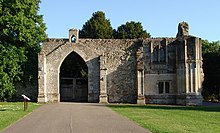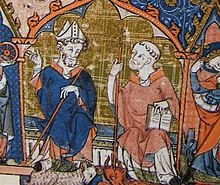Ramsey Abbey
The Ramsey Abbey in Ramsey , Cambridgeshire , was one of the oldest and most important Benedictine monasteries in pre-Reformation England . It existed from 969 to 1539. Today there are only small remains of the buildings.
history
Æthelwine , Ealdorman of East Anglia , founded and endowed the monastery in 969 on an island ( Ram's eie - "ram island") in the then marshland - and marshland around the mouth of the Great Ouse . He was supported by Bishop Oswald von York . The first abbot was Æthelwines nephew Eadnoth . He had a wooden connecting bridge from the marshland to the Geestland and a monastery built. The first twelve monks came from Westbury Priory in what is now the city of Bristol . The monastery church , consecrated for the first time in 974 and again by Bishop Oswald after the tower collapsed and rebuilt in 991 , received the patronage of the Mother of God Maria and St. Benedict .
The eminent scholar Abbo stayed in Ramsey from 985 to 987 before becoming abbot of his home monastery, Fleury . He founded the Ramsey Convent School .
In 1001 the relics of St. Ivo and in 1026, under Canute the Great , relics of St. Felix came to Ramsey. They made the abbey a much-visited place of pilgrimage .
In 1110, Henry I granted Ramsey the privilege of holding an annual trade fair . A new, larger abbey church in Romanesque style was consecrated in 1123.
During the Civil War from 1135 to 1154 , Geoffrey de Mandeville used the abbey as a fortress, leading to its bloody conquest and destruction in 1143.
After the reconstruction, a new period of prosperity followed, of which the Ramsey Psalter is the most important testimony. In the 1230s, the former monastery inn was converted into the parish church of the growing village and consecrated to St. Thomas Becket . The heyday ended with the plague epidemic of 1349. In the 15th century, brick production became the main economic base of the monastery. The gatehouse was built in 1475 .
The Abbot of Ramsey had a seat in the Upper House of Parliament and was third among the abbots after Glastonbury and St. Alban's .
The abbey was abolished as part of the English Reformation. The last abbot, John Wardeboys, agreed to the dissolution and received a generous pension from the king as compensation. Richard Cromwell (1502–1545) became the owner of the monastery . This started the demolition of the buildings and the sale of the stones as building material etc. a. for Trinity College , Cambridge . In 1558 the Cromwell family converted the remains of the convent building into a residential building; Oliver Cromwell took up residence there from 1627.
In the 18th century, the property became the property of the Coulson Fellowes family , who then received the title of Barone de Ramsey . They expanded the ensemble in the 19th century in the spirit of historicism . In 1931 the house became a school building. The gatehouse was given to the National Trust . Today it is the only remainder of the monastery complex besides the college and the parish church of St. Thomas Becket.
Web links
- Article Ramsey Abbey , Catholic Encyclopedia , 1913 (English)
- Timetable on the abbey grounds (English)
Coordinates: 52 ° 26 '55.5 " N , 0 ° 6' 6.3" W.

